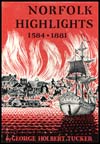Chapter 22
The Burning of Norfolk
When Miss Ann Archdeacon and her fiance, James Nimmo, applied for a marriage license on August 24, 1797, John Ingram, her guardian, wrote the following to the clerk of the Norfolk Corporation Court: "Miss Nancy Archdeacon was born on the first day of January 1776, a remarkable day for this town."
He was referring to the destruction of Norfolk by the British and colonial troops that began on New Year's Day of 1776. When it was completed, Norfolk had the dubious distinction of being the most devastated community of its size in the American colonies during the Revolution.
The Norfolk area, where the Tory element was strong, had been the base of operation for Lord Dunmore, the last royal governor of Virginia, since he had fled to the safety of the British warships in Virginia waters in June of 1775. And until his forces were defeated at the Battle of Great Bridge on December 9, 1775, he more or less had things under his control. Dunmore's defeat at Great Bridge, however, turned the tide and from then on Norfolk's fate hung in the balance.
Five days after the battle, the Virginia troops under Colonel William Woodford occupied the borough, from which most of the inhabitants, including the leading Tory families, had fled, the latter seeking refuge aboard Dunmore's already crowded ships in the harbor. Five days later, Colonel Robert Howe and his North Carolina provincial troops arrived, after which Howe assumed control of all the colonial forces in Norfolk.
From then on, Howe's sharpshooters, stationed in high and secluded places along the waterfront, began picking off anyone who dared to show his head above deck on the British ships.
Intense cold, the crowded conditions aboard the ships, and near starvation finally forced Dunmore to act, but when he demanded food from Howe he flatly refused. This sparked the cannonading by the British that began the destruction of pre-Revolutionary Norfolk.
The firing began about 3:15 p.m. on New Year's Day of 1776, and continued until 2 a.m. on January 2. Under the cover of a constant bombardment of double-headed bar, chain, and grapeshot, British landing parties attempted to rifle the waterfront warehouses, but in most instances they were repulsed by Howe's men.
But Dunmore and his followers, popular tradition to the contrary, were not the only villains in the destruction of Norfolk. For according to H.J. Eckenrode's "The Revolution in Virginia" (1916), an authoritative source book on the subject compiled from original documents in the Virginia State Archives:
"The fires began by balls and landing-parties, spread with great rapidity, because the provincial soldiers, instead of attempting to extinguish them, seized the opportunity to plunder and destroy on their own behalf, determined, as they said, 'to make hay while the sun shines.' Breaking into rum-shops and warehouses, many of them soon became drunk and went in gangs from house to house, smashing in doors, dragging out spoils, and then applying the torch. Household goods of every kind were sold in the street for a song to anybody willing to buy. The destruction caused by the ships was confined to the waterfront, but the Virginia soldiers involved the whole place in the catastrophe. On January 2, 1776, when the firing had ceased, the riflemen continued their work of rapine without interference on the part of their officers -- apparently even with their connivance. Only on the third day did Woodford put an end to the sack by forbidding the burning of houses under severe penalty, but by that time more than two-thirds of Norfolk was in ashes. In February, 1776, the remainder was destroyed by order of the convention in order to deprive Dunmore of shelter."
Chapter
23
The Coming of the French
Norfolk Highlights 1584 - 1881

See the "Table of Contents" for links to every chapter in Norfolk Highlights 1584 - 1881 by George Holbert Tucker.
